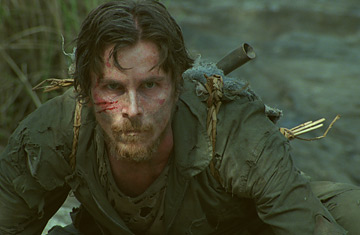
Rescue Dawn
Opportunities for training were scarce in post-war Germany, so Dengler emigrated to the U.S., went college, joined the navy, won his wingsand was shot down on his first mission over Laos in 1966, well before the war in Southeast Asia tragically expanded. Captured and imprisoned in what may well be the most horrendous POW camp ever shown in a film, Dieter somehow managed to escape through the jungle — an odyssey that is, if anything, more gut-wrenching than his incarceration.
It almost goes without saying that Dengler's story would attract (and obsess) Werner Herzog, a director drawn to portrayals of men driven to extreme behavior in extreme situations. Herzog's features — Aguirre the Wrath of God, Fitzcarraldo — and his conditions — notably the great Grizzly Man— provide ample and thrilling testimony to the uniqueness of his enterprise. He is willing to go places no other filmmaker goes and he simply has no competitors when it comes to strenuous risk-taking. About a decade ago he made a hypnotic documentary about Dengler's exploits, entitled Little Dieter Needs to Fly. In it, Dengler returned to the scenes of his Laotian exploits and recounted them in the matter of fact way that heroes so often affect when they are encouraged to reflect on their pasts. Now, in Rescue Dawn, Herzog offers a fictionalized account of the same story, which seems to me somewhat less compelling than the documentary.
That's not to say that the new film, which stars Christian Bale as Dengler and Steve Zahn as the man who joins him in escape, is anything less than authentic and austere in its evocations of the primitive cruelties these men endured both in prison and during their escape. It has the ability to show us, in grim detail, things that Dengler, in the previous film, could only haltingly allude to. Yet, in so doing, it shifts our perspective. Inevitably, we start thinking about other POW escape movies and judging this one by their fictionally enhanced standards. Dengler becomes, in this incarnation, an almost merry soul, dauntlessly rallying his bedraggled troops (there are only six men in this camp). We're obviously not talking Stalag 17 or The Great Escape here, but stray thoughts of movies in that mode inevitably tug at our minds and somewhat vitiate the power of this one.
Most of all, we miss the living presence of Dieter Dengler, who died five years ago. When we met him in Little Dieter, he was driving in a solid car, living in a stolid middle class house, having spent the rest of his life as a test pilot (he managed to survive four more plane crashes), apparently unmarked by his youthful adventures. That came to be the most heroic thing about him — his ability to embrace normalcy, to talk about the past almost as if it were a story that happened to someone else. There was a tranquility about him and a good nature that was close to awesome. There were also things that he omitted from his story — especially about the other men with whom he was imprisoned — that lent an air of mystery to his tale that was both discreet and intriguing.
It's odd, isn't it? A fictional movie that is in some sense more literal and less haunting than the documentary version of the same story. Werner Herzog is a great and demanding filmmaker — sort of a Joseph Conrad for our time — and there is nothing notably wrong with Rescue Dawn. If you have the stomach for it, it will hold your attention. But it is still Little Dieter, toying with the unspoken enigmas of heroism, which elevates this tale to the level of art.
